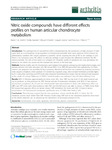| dc.contributor.author | Andrés, María C. de | |
| dc.contributor.author | Maneiro, Emilia | |
| dc.contributor.author | Martín, Miguel A. | |
| dc.contributor.author | Arenas, Joaquín | |
| dc.contributor.author | Blanco García, Francisco J | |
| dc.date.accessioned | 2020-10-16T09:27:15Z | |
| dc.date.available | 2020-10-16T09:27:15Z | |
| dc.date.issued | 2013-09-11 | |
| dc.identifier.citation | de Andrés MC, Maneiro E, Martín MA, Arenas J, Blanco FJ. Nitric oxide compounds have different effects profiles on human articular chondrocyte metabolism. Arthritis Res Ther. 2013;15(5):R115 | es_ES |
| dc.identifier.issn | 1478-6354 | |
| dc.identifier.uri | http://hdl.handle.net/2183/26444 | |
| dc.description.abstract | [Abstract] Introduction. The pathogenesis of osteoarthritis (OA) is characterized by the production of high amounts of nitric oxide (NO), as a consequence of up-regulation of chondrocyte-inducible nitric oxide synthase (iNOS) induced by inflammatory cytokines. NO donors represent a powerful tool for studying the role of NO in the cartilage in vitro. There is no consensus about NO effects on articular cartilage in part because the differences between the NO donors available. The aim of this work is to compare the metabolic profile of traditional and new generation NO donors to see which one points out the osteoarthritic process in the best way.
Methods. Human healthy and OA chondrocytes were isolated from patients undergoing joint replacement surgery, and primary cultured. Cells were stimulated with NO donors (NOC-12 or SNP). NO production was evaluated by the Griess method, and apoptosis was quantified by flow cytometry. Mitochondrial function was evaluated by analysing respiratory chain enzyme complexes, citrate synthase (CS) activities by enzymatic assay, mitochondrial membrane potential (Δψm) by JC-1 using flow cytometry, and ATP levels were measured by luminescence assays. Glucose transport was measured as the uptake of 2-deoxy-[3H]glucose (2-[3H]DG). Statistical analysis was performed using the Mann-Whitney U test.
Results. NOC-12 liberates approximately ten times more NO2- than SNP, but the level of cell death induced was not as profound as that produced by SNP. Normal articular chondrocytes stimulated with NOC-12 had reduced activity from complexes I, III y IV, and the mitochondrial mass was increased in these cells. Deleterious effects on ΔΨm and ATP levels were more profound with SNP, and this NO donor was able to reduce 2-[3H]DG levels. Both NO donors had opposite effects on lactate release, SNP diminished the levels and NOC-12 lead to lactate accumulation. OA chondrocytes incorporate significantly more 2-[3H]DG than healthy cells.
Conclusions. These findings suggest that the new generation donors, specifically NOC-12, mimic the OA metabolic process much better than SNP. Previous results using SNP have to be considered prudently since most of the effects observed can be induced by the interactions of secondary products of NO. | es_ES |
| dc.description.sponsorship | Instituto de Salud Carlos III; CIBER- CB06/01/0040 | es_ES |
| dc.description.sponsorship | Instituto de Salud Carlos III; PI-12/00329 | es_ES |
| dc.description.sponsorship | Instituto de Salud Carlos III; RETIC-RIER-RD12/0009/0018 | es_ES |
| dc.description.sponsorship | Ministerio de Ciencia e Innovación (España); PLE2009-0144 | es_ES |
| dc.language.iso | eng | es_ES |
| dc.publisher | BioMed Central | es_ES |
| dc.relation.uri | https://dx.doi.org/10.1186%2Far4295 | es_ES |
| dc.rights | Atribución 4.0 España | es_ES |
| dc.rights.uri | http://creativecommons.org/licenses/by/4.0/es/ | * |
| dc.subject | Chondrocytes | es_ES |
| dc.subject | Nitric oxide | es_ES |
| dc.subject | Apoptosis | es_ES |
| dc.subject | Mitochondria | es_ES |
| dc.subject | Glucose | es_ES |
| dc.subject | Osteoarthritis | es_ES |
| dc.title | Nitric Oxide Compounds Have Different Effects Profiles on Human Articular Chondrocyte Metabolism | es_ES |
| dc.type | info:eu-repo/semantics/article | es_ES |
| dc.rights.access | info:eu-repo/semantics/openAccess | es_ES |
| UDC.journalTitle | Arthritis Research and Therapy | es_ES |
| UDC.volume | 15 | es_ES |
| UDC.issue | 5 | es_ES |
| UDC.startPage | R115 | es_ES |






